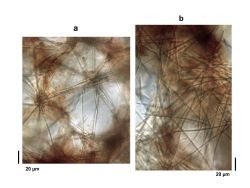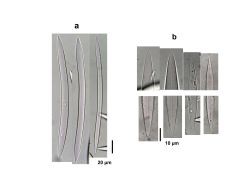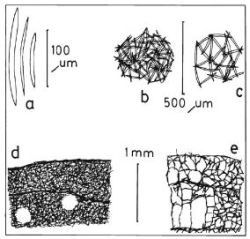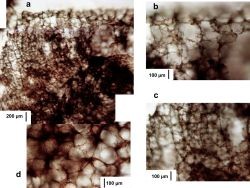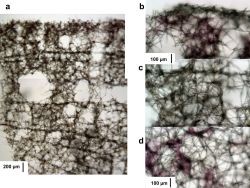gray
brown
cream
cinnamon-tan
branching
encrusting
lobate
massive
tube
crumbly
Bahamas
Colombia
Panama
Calyx podatypa
Description: The only specimen found in the Bahamas is a mass of about 10 x 10 x 5 cm partly buried under the side of a coral, reddish brown, with a central, 1 cm diameter oscule and several smaller scattered ones, all slightly elevated. Continental Colombian specimens are repent, cylindrical hollow branches, up to about 1-2 cm in diameter, buried among corals, yellowish brown, with isolated or grouped oscules, 1-2 mm in diameter, often contorted, with a slightly elevated rim wall. Panamanian specimens are grayish brown and range in shape from lobed encrustations to erect anastomosed branches, which are irregular, having up to 1 cm thin portions followed by masses 2-5 cm thick and then by 2-5 mm wide branchelets. All these specimens are characterized by having a cavernous interior that is visible at the surface where roofs are thin or below groups of oscular openings. The consistency is thus firm but crumbly. The skeleton is a uni to paucispicular isotropic reticulation, forming triangular to polygonal meshes 100-150 µm in diameter, often confused by crisscrossing spicules, and here and there with clearly ascending tracts, 2-5 spicules thick. Colombian (see Zea, 1987) and Panamanian specimens have horizontally-placed tracts, 4-6 spicule thick, ca. 40 µm in diameter, which appear as growth lines, placed at 100-600 µm intervals. At the surface there is a unispicular reticulation with triangular meshes, overlying the more confused interior; in some portions it becomes a sheet of confused spicules. Spicules are hastate oxea, slightly curved, very thin and smaller in the Bahamas material, 92-122 µm long by up to 2 µm wide; southern Caribbean material has thicker and longer spicules, with conical short endings, generally pointed, 95-216 µm long by 1.9-11.8 µm wide.
Notes: This species lives partly cryptic to exposed in lagoonal settings and shallow and deep reefs (see also Rützler et al., 2014). Its name was mistakenly used for Svenzea zeai (Alvarez, van Soest & Rützler, 1998) , also pictured here, but it is a distinct species. It was originally described under genus Haliclona and later placed under Pachypellina (see van Soest, 1984; Zea, 1987). Haliclona dura Sandes, Bispo & Pinheiro, 2014, recently described from tropical Brazil should be compared in detail, as the overall shape matches some of our studied specimens; it has oxeas with irregular endings, 105-193 x 2.5-9 µm. Care should be taken in comparing coexisting, crevice-filling specimens of Neopetrosia rosariensis (Zea & Rützler, 1983) and N. proxima (Duchassaing & Michelotti, 1864), both also pictured here. Deep-water Calyx magnoculata van Soest, Meesters & Becking, 2014 has oxea that attain larger sizes (141-264 x 6-13 µm); some deep-water material previously described as C. podatypa and by van Soest (1980) and van Soest & Stentoft (1988) may belong to C. magnoculata (see van Soest, Meesters & Becking, 2014).
Author Reference: (de Laubenfels, 1934)
Link: World Porifera Database

![<i>Calyx podatypa</i> <br />[Colombia, Islas de San Bernardo]](mini/00117/02139.jpg)
![<i>Calyx podatypa</i> <br />[Colombia, Islas de San Bernardo]](mini/00117/02140.jpg)
